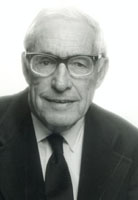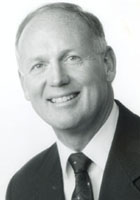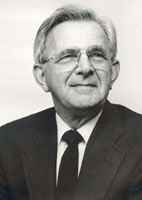 |
||||
|---|---|---|---|---|
 |
 |
 |
 |
 |
| Charlie Bassett Spring Lake |
Carl Engels Kalamazoo State University High |
Harold Holcomb Essexville Garber |
Clare Pott Holland Christian |
Bob Quinn Saginaw Heritage |
 |
||||
|---|---|---|---|---|
 |
 |
 |
 |
 |
| Charlie Bassett Spring Lake |
Carl Engels Kalamazoo State University High |
Harold Holcomb Essexville Garber |
Clare Pott Holland Christian |
Bob Quinn Saginaw Heritage |
(click on Inductee's name to read 'description')

When Charles Bassett was a star athlete at Hastings High School, he played tennis but it certainly wasn't his best sport. He was good enough in football to be named Honorable Mention All State and won the state championship in wrestling at the 165 pound class in 1961, his senior year. He didn't begin to play tennis until his freshman year under coach Bruce Withers but worked his way up to the first doubles position during his junior and senior years. However, he took a class in the coaching of tennis under the venerable Hap Sorrenson during his years at Western Michigan University. When the tennis position became available during his second year of teaching at Spring Lake, he was ready.
Ascribing to a commonly held belief that tennis players are made in the summer, not in the spring, Charlie established a flourishing summer recreation program of which he has been the director for the past 21 years. By getting his Spring Lake kids involved in the WMTA's R.E.Elis Inter-City program, he tournament-hardened his high school players and trained junior high players who were experienced in the rigors of match pressure even before reaching high school. Construction of seven new courts this past summer will serve to enhance this already successful program.
Another ingredient to Charlie's success was that he immediately began to host tournaments and continues to do so. He established an invitational tournament for the boys in 1971 which has been a part of the Spring Lake schedule ever since. He did the same for the girls in 1974 when that program began. In addition, he has not been shy about volunteering to host MHSAA regional tournaments, having overseen a total of 29, 15 for the boys and 14 for the girls. All of this has not only enabled his kids to gain valuable experience while playing at home but has also served to put Spring Lake "on the map" as mecca for high school tennis competition.
Running high school tournaments and a summer program has certainly paid off as Spring Lake is firmly "on the map" in terms of being known state-wide for its successful tennis teams. Under the old 3 singles, 3 doubles format, Charlie's boys won the regionals once and he coached a doubles team to the semi-finals of the state tournament. Under the team format, Spring Lake has won 5 regional tournaments, placed 2nd three times, and third 8 times, finishing as high as 5th in the state in 1986. His two most noteworthy players, Craig Wildey and Jeff VanDenBerg, were known throughout the state for their excellence. While playing for the Lakers, Craig was named to the all-state team for three years and to the Prince All-American team for two. Jeff won the state championship at No.2 singles and was also all state for three years.
The girls also did their part to put Spring Lake on the map. From the beginning, they won over 70% of their matches, captured 11 conference titles, 7 regional titles, and placed second in the regional 5 times. In the midst of all of this, the MHSTeCA selected Charlie as its girls coach of the year in 1980 and its boys coach of the year in 1988.
Charles Bassett's tennis activities go far beyond coaching successful high school teams. He has been a member of the MHSTeCA since its inception and was so highly regarded as to be elected its president in 1984. During his term, our organization was restructured into districts with specific areas of responsibility and witnessed its first Hall of Fame induction. For a number of years, he produced the association's directory and developed its scorebook. The Hall of Fame program that we enjoy, along with several others previous to this one, was produced by Mr. Bassett and is in itself, a testament to the standard of excellence to which he applies himself.
When players, coaches, and parents consider Charlie, they don't spend much time on his achievements. Instead, they talk about his positive attitude toward competition and his emphasis on proper behavior. Parents and players alike laud his emphasis on sportsmanship. One of his players wrote: "I never threw my racquet; I never swore on the court: I never yelled at my opponent, simply because he taught me that was wrong." Such words are a fitting legacy for a man who, in the words of another player, "puts more emphasis on sportsmanship, good attitude, and proper behavior than on winning." As Charlie himself has said, "The important thing is to play the best that you can every time and the winning will take care of itself." Certainly this man, a living testimony to the truth of his own words, belongs in the Hall of Fame.
In high school sports, winning the state championship is the fantasy of every coach and his/her team. Very few squads realistically think they will attain this goal and very few who feel that they have a chance actually go on to capture a StateTitle. This is what makes the accomplishments of many of Carl Engels' teams so remarkable. From 1947-1964, no fewer than 7 of his squads captured state championships. What is even more amazing is that Engles-coached teams won state titles in three different classes, something that no other tennis coach in Michigan high school tennis history has achieved.
Mr. Engles participated in track, no tennis, in high school and college but when he came to Wyoming Park in January of 1943, he coached all sports except baseball. His experience in directing players in reserve football, basketball, and track stood him in good stead. Since his track team had won 4 regional titles and his basketball team had won 3 league basketball championships on their way to a 30-6 record in those years, it seemed a natural extension of Carl's coaching abilities for him to direct the tennis team to a regional championship in 1946. Although he was not an accomplished player, he played regularly with many of his charges who rewarded his efforts with a Class C state Championships in 1947.
In 1953, Carl transferred to the University High School at Western Michigan University in Kalamazoo where he taught math and science and coached junior high school basketball. Recognizing his talent for fielding winning athletic teams, the school hired him to coach the tennis team in 1955. He did not disappointment anyone. Coaching Kalamazoo boys, many of whom learned to play in the Kalamazoo Colleges Stowe Stadium, Carl's University High teams won 5 Class B State Championships. From 1955-1 964, Carl's teams did not lose a league match and defeated perennially powerful Holland after the Dutch had won 60 matches in a row.
Perhaps the most memorable championship, however, came in 1960, when University High opted to play Class A tennis with the purpose of bringing legendary Hamtramk's long string of class A state championships to an end. It was one of the most intriguing setups in state championship history as this powerful challenger marched toward a showdown with the champion in in Kalamazoo that June. When Dick Colby reached the singles final and the doubles team of Brad Hodgeman and Bob Gill captured the state title over their Hamtramck counterparts, Mr. Engls' team succeeded in ending the legendary Jean Hoxie's string of 11 consecutive state titles.
Jn 1964, Carl and his family were transferred by Western Michigan University to Western Nigeria where he was a science advisor in a technical college developed by WMU and the United States Agency for International Development. Since there were no sports programs there, he started tennis, track, and basketball teams, often having to scratch basketball and tennis court lines in the clay. He rounded up Peace Corps volunteers, assigned them as coaches to area high schools, and organized league competition. He also taught the area's Military Governor to play tennis, an accomplishment which escalated into twice a week matches on the courts at the Government House in which judges, military officers, heads of the Civil Service, and one occasion, the Russian Ambassador, took part.
Carl retired from WMU in 1985 but enjoyed a brief stint as coach of the Kalamzoo Hackett girls in the fall of 1990, thus extending his coaching career, with interruptions, from 1944 to 1990. Anyone who has coached for as long and who gained as much success as he inevitably attains a sense of posterity. Prof. Engels observes that most of the players on his tennis teams still enjoy playing tennis and most of their children are tennis players. His own son played on two of his father's state championship teams, played at Kalamazoo College for four years, coached at Kalamazoo Valley Community College for two years as a second job, and his son, Carl's grandson, is himself a solid high school player.
The Michigan High School Tennis Coaches Association places Carl Engles in a group of some of the most successful high school tennis coaches in history. His teams have accomplished as much as the teams of almost any coach previously inducted. In addition, Carl went on to welcome a world-wide ambassador for tennis. Certainly, his inclusion into the Hall of Fame makes this group that much more complete.
Essexville-Hampton is a small semi-rural school district with a student count of approximately 1700 kids, 550 of whom attend the high school. Twenty years ago, football was the school's most popular sport with basketball, track, and baseball being strong second choices for its male students. The high school had 4 tennis courts and no organized program other than boys varsity squad. The Dukes had never won a regional tennis championship nor qualified for state competition.
Enter Harold Holcomb. This man is a remarkable example of the impact that one individual can make on the tennis program of a community. Over the time span of twenty years:
Not surprisingly, Mr. Holcomb has had an impact that goes beyond local contributions. In 1983, he was elected the association's state boys coach of the year and received the same honor in 1987 as MHSTeCA's Girls Coach of the Year. He has served on the MHSAA'ss State Seeding Committee since its inception, an exceptional contribution given the arduousness of this group's task. He has been active in various functions of our association, most notably as president in 1980-82.
The community of Essexville-Hampton is a better place to live because of Harold Holcomb's efforts. Students and parents alike have benefited from his tennis promotions. Last year, sixty of his former players from all over the country attended reunion in his honor, a clear manifestation of the love, the respect, and the devotion that they have had for their coach over the years. Anyone who has met him has found him to be a caring,compassionate, sensitive individual, one who clearly belongs in the Michigan High School Tennis Coaches Hall of Fame.
Some of the best tennis coaches in the state, including several who have been inducted into the Michigan High School Tennis Coaches Hall of Fame, have been former football and/or baskerball coaches who have transferred their leadership skill to this curious amalgamation of individual and team concept that is high school tennis. These people bring to their taskes considerable training in molding individuals into a team, a clear sense of what it takes to win, and the ability to discipline.
Such is the case of Bob Quinn who not only played football and basketball, but was also on the track team at Montague High School in the early 60's. This training instilled in him a solid background in the fundamentals of athletic competition as he began his coaching career as an assistant varsity football coach and head track coach at Saginaw Buena Vista. That fall, Buena Bista was Class B state football champion. Lessons in how to coach winners endured when, in 1971, he was asked to be head JV football coach and head tennis coach at MacArthur High School. Bob admits that ke knew almost nothing about the sport having only played recreational tennis with his brother after work one summer, but accepted the tennis job because he wanted to coach football. Little did he know at the time that this decision would lead to a career that became so successful and respected that is has resulted in his induction into the Tennis Coaches Hall of Fame.
In the early 70's, Bob immersed himself in a game that quickly became fascinating to him. He devoured books, talked incessantly with other coaches, commiserated with another fledgling coach, his friend Harold Holcomb of Essexbille Garber, and drew support and knowledge from MHSTeCA Hall of Famer, Jim Teal, who was the coaching guru of Saginaw and the coach at Eisenhower High School. By working both himself and his players hard and by closely observing how the successful coaches around him operated, impressive results ensued. From 1972-1976, MacArthur's boys teams always qualified their number one singles players to the state meet. Beginning with the flight format in 1977, the Generals qualified their teams to the Class B Final Tournament every year from 1977 through 1988 with the exception of one year. During this span, they won the regional trophy 9 times and finished second 5 times.
Perhaps sinsing that his coaching destiny lay elsewhere, Bob quit coaching football in 1974 and took over the girls program. They rewarded his decision by qualifing for state competition every year from 1976-1987. Their best finish was an impressive second place tie with East Grand Rapids in 1981. During this time span, MacArthur's girls teams won the regional 9 times and fmished 2nd three times.
In other words, at the time that Saginaw Douglas MacArthur closed in June of 1988, Quinn's teams contributed 18 MHSAA trophies to the school's trophy case. In addition, Bob's boys won 14 White Pine Conference Championships from 1972-1985 and finished no worse than second form 1986-88. His girls captured 13 conferences which totaled 27 more trophies for the bulging MacArthur showcase.
For someone who had not spent much time with the game of tennis, Bob gained a remarkable amount of respect among his peers in a short amount of time. A charter member of our asociation in 1977, he was elected first vice president that year which made him the second president in our group's history in 1979-80. Although this seems a long time ago, he continues to substantially contribute to statewide tennis by conducting the semi- annual coach of the year balloting. In addition, he has served on the MHSAA State Seeding Committee since its inception. He has run too many weekend tournaments to count and has done an excellent job of directing the state's regional tournament for over a decade. He has directed the Saginaw Township Recreation tennis program since 1980.
The number of championships that Bob's teams have captured is, by itself; sufficient evidence that he is an exceptionally competent coach. In addition, what makes him a cut above many other coaches is his willingness to serve, not only his kids, but high school tennis in general. He has never been afraid to accept a challenge, even if it meant traveling in unfamiliar territory. The quality and extent of the contributions that he has made to his program in Saginaw, our association, and to high school tennis in general give him a well-deserved place in a special group of the finest tennis coaches in the history of the sport in Michigan, the Hall of Fame.
Leo Martonosi of the Holland Sentinel wrote in February of 1989, "Clare Pott and Holland Christian: They go together like a burger and onions. One isn't quite as good without the other." Mr. Martonosi's simile summarizes the special relationship between a man and his school that spanned an astonishing 41 years of service. Clare not only attended the school as a student in 1937-41 but after earning his degree at Calvin College and spending a year at Holland Christian Middle School, he taught mathematics there for over four decades and served as the school's athletic director for thirty of those years.
Mr. Pott also found time to very successfully coach Holland Christian's tennis team during a period that includes avariety of time spans but consistent success. He coached the boys from 1952-1955, where in his players compiled an astonishing 43-1 dual met record and captured two state championships. Clare then quit because he became Holland Christian's basketball coach as well as athletic director but resumed his tennis duties in 1959 and led his charges to a 121-24 record over the next 11 years. Holland Christian tennis teams were exceptionally strong in the sixties: They won two more state championships, one in 1963 and the other in 1965, were runners up in the state twice (1961 and 1968) and finished in 4th place in the state at the end of the one year that the team played in Class A. Along the way, Mr. Pott coached his kids to 12 regional titles, guided two doubles teams to state championships and saw another doubles team and two singles players reach the final round of the state tournament. In all, Pott- coached boys teams won 164 dual meet against only 26 losses, a very impressive 87% won-loss record.
Although there was no organized high school tennis program when Clare was growing up, he played the sport often in the summer as a member of the city's recreation team. A frequent playing partner was MHSTe CA's Hall of Famer, Joe Moran, with whom Clare coached in the fifties. Because there were only ten courts at that time in Holland, the two coaches split them, Joe taking five of them to drill his Holland High School kids while Clare using the other five for his Maroons. As a result of this arrangement, the two teams often scrimmaged, producing some spirited practice sessions that evolved into strong teams for both schools. Indeed, the records clearly reveal that in the 60's, the teams of Joe Moran and Clare Pott set the standard for tennis excellence in Holland. The two squads only competed one year when Holland Christian moved up to Class A: the Dutch won the dual meet but Clare`s kids prevailed at the regional.
In 1969, Clare quit tennis coaching once again to devote full time to his job as mathematics teacher and athletic director. However, he came out of retirement once more in 1975 to fill in for the girls tennis coach and once again provided the winning touches for some talented Holland kids. In his one season as girls tennis coach, his team won 9 matches against only one loss and came in 3rd in the state in the Class B Final Tournament. Also, once again, Mr. Pott coached a doubles team to State Title.
As athletic director, Clare was accustomed to working with other schools to solve a variety of problems. In this capacity, it was only natural that he volunteer his talents in the administration of tennis statewide. He served on the Michigan High School Athletic Association Rules Committee several times, twice for the girls and five tirnes for the boys. Locally, he worked ceaselessly to promote tennis, serving on several recreation committees for the city of Holland. Future Holland Christian coaches must have counted themselves very fortunate that when it came time to plan new tennis courts at the school, the school had a highly successful former tennis coach who also happened to be the athletic director to oversee construction. Very few schools have a current or even former tennis coach as its athletic director and those that do invariable have successful programs.
In spite of all this success, few people in th Holland area regard Clare as merely a coach of winning tennis teams. Indeed, he is universally regarded as genuinely warm and kind individual who relates exceptionally well to kids. It is understandable that in June of 1989, over 250 people surprised him whith a retirement party. At that time, the Clare Pott Achievement Award was established, one which is to be awarded to the senior boy and girl who best exhibits the values for which Pott stood. These values, instilled in so many young people for so many years, make this much- loved individual deeply respected by his former players and colleagues. Inclusion in the Mihigan High School Tennis Coaches Hall of Fame serves to symbolize the quality of service rendered by this venerable man. In Clare's case, it also serves to enhance the award itself.